16 October
Global Seminars & Invited Speaker Series
HYDRAULIC HERITAGE IN NAVARRA
The bequest of Roman engineering. The dream of water
Carmen Jusué Simonena
UNED Pamplona
It is interesting to begin with a historical quotation by Vitruvius, from The Ten Books of Architecture: "Water is indispensable for life, for satisfying pleasurable needs and for everyday use", which gives us a clue as to how important topic water was for the Romans.
Since the beginning of man's existence, water has been one of the fundamental axes on which the development of any settlement, city or culture has been based. Thus, there are remains of hydraulic works in Egyptian, Mesopotamian, Greek and Chinese cultures, but without a doubt none equalled the skill with which the Romans managed to capture water, treat it, distribute it and dispose of it once it had been used.
What do you think of when you hear the expression Roman aqueduct, a row of arches disappearing into the horizon? In reality, aqueducts were mainly underground. Only 20% of the route was over arches. This saved money, protected the aqueduct from erosion and minimised the impact on fields and populated areas. For example, the Aqua Marcia, which was completed in 140 BC, was about 92 kilometres (57 miles) long, but had only 11 kilometres (7 miles) of arches.
The Romans built numerous aqueducts to provide water to cities and industrial sites in their empire. These aqueducts were among the greatest engineering achievements of the ancient world and set an unequalled standard for over a thousand years after the fall of Rome. The city of Rome itself, as the largest city, had the greatest concentration of aqueducts, with water provided by eleven aqueducts built over a period of five hundred years.
They provided drinking water, numerous baths and fountains in the city. financial aid The methods of construction were well described by Vitruvius in his work De Architectura, written in the 1st century BC. His book was of great importance to the administrator of Rome's water supply, Sextus Julius Frontinus (35-c. 103), the general appointed in the late 1st century to administer Rome's many aqueducts, and in his work De aquae ductu Urbis Romae (listing the nine aqueducts then in existence) of the late 1st century, where he explains his theories for improving and regulating the system.
Frontino had this to say about these constructions: "The numerous and necessary benefits of so many aqueducts cannot be compared with the pyramids, which are obviously useless, or the works of the Greeks, useless, but celebrated everywhere".
There are several sites in and around Navarre that have a series of elements of great interest related to water: aqueducts, dams, water tanks, cisterns, water conduits, thermal baths...
Alcanadre - Lodosa Aqueduct. Also known as the "Puente de los Moros" (Moors' Bridge), it has been declared a Historic-Artistic Monument. Its main distinguishing feature is the robustness of the pillars, which in these Roman constructions are usually stylised, but which in this case is necessary to withstand the strong current and the floods of the river Ebro. Also, sample has an unusual width, which leads us to believe that it was used as a bridge to cross the Ebro and its arches (13 of the 108 that it once had remain today), with a span of 4.80 metres.
This Roman-period construction is located in the municipalities of Alcanadre and Lodosa, on the border between the provinces of Logroño and Navarre. It was built over the River Ebro to supply water to the Roman city of Calahorra(Calagurris). It was built in the 2nd century, during the time of the emperors Trajan and Hadrian, when public works were frequent. The water came from springs near the area of Estella, specifically from the rivers Odrón and Linares.
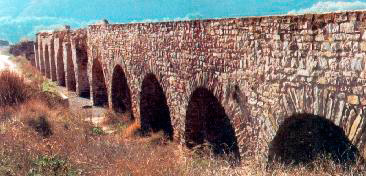
Alcanadre - Lodosa Aqueduct.
Andelo, Andión, Mendigorría. As visitors approach the domains of the Roman city of Andelo, they can see how calm has replaced the bustling atmosphere of the streets that presided over the life of its inhabitants in the early years of our era.
Improving the quality of life in cities was one of the main objectives of Roman engineering, and perfecting water supply systems was one of its main contributions. In Andelo, despite its proximity to the Arga riverbed, they took advantage of the resources offered by one of the nearby streams to supply water. The different infrastructures that formed part of the hydraulic system, from the catchment area to the distribution centre in the city, are exceptional, as is finding . A dam, a canal that led the water to a reservoir near the city, an aqueduct, a castellum aquae from which pipes ran throughout the city and thermal baths are the exponents of this hydraulic system at Andelo.
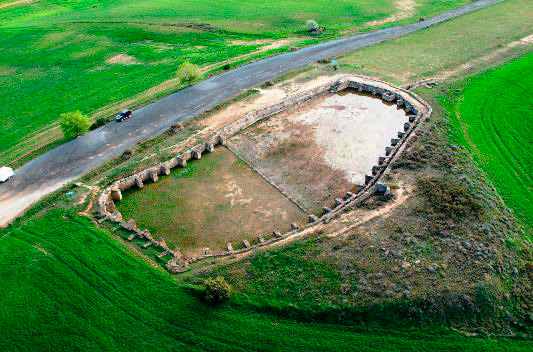
Water reservoir of the Roman city of Andelo.

Detail of the water tank of the Roman city of Andelo.
The town of Arellano. The town of Arellano dominates a small valley, bordered to the south and west by the Cortabaco mountain range and to the north by the foothills of Montejurra. The landscape, despite the logical transformations, preserves the essence and appearance that these lands must have had in Roman times; a colourful mosaic where the small hills populated by holm oaks, oaks and pines intertwine with fields devoted to the ancestral crops of the Mediterranean triad: cereals, vines and olives.
Under the floor of the entrance hall of the oecus or main hall, the reservoir of the primitive villa was located, which was fed mainly by rainwater. With dimensions of 7x8 metres and a depth of 3 metres, its capacity was around 150 m³. For its construction, the rock was previously excavated and reinforced with stone masonry walls lined with a thick layer of hydraulic mortar for waterproofing, consisting of a mixture of water, lime, sand and tile dust. The cistern was covered by a double vault supported on the outside by the side walls and on the inside by pillars. The finding of this cistern in the town of Arellano is of an exceptional nature, given that the water supply in towns used to be provided by digging wells, cisterns being more typical of Mediterranean areas.
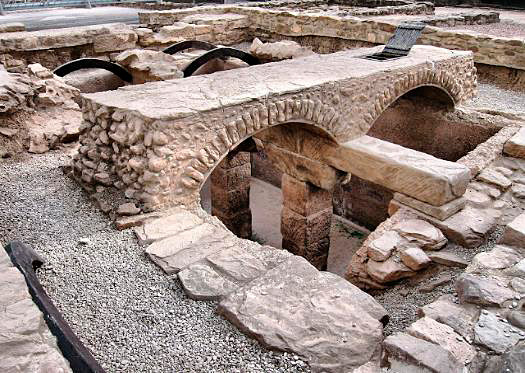
Cistern of the Roman villa of Arellano.
San Julián archaeological site in Beire (Navarre). Archaeological settlement located to the south of the town of Beire, on a small mound some 4 metres high and about 60 metres in area, discovered in the 1980s during a surface survey of the area at project .
By Resolution 350/2012, of 30 October, the Archaeological Area known as San Julián de Beire (Navarre) was declared an Asset of Cultural Interest, with the favourable opinion of the Historical Heritage Commission of committee Navarro de Cultura. Settlement in this area began in the 1st century AD in the area around the Roman road linking Cara and Pompelo. The thermal baths of the uilla were discovered on the site, with two pools and rooms with a hypocaust system (underground heat circulation) and mosaic. This finding prompted the reservation of land in order to preserve the site.
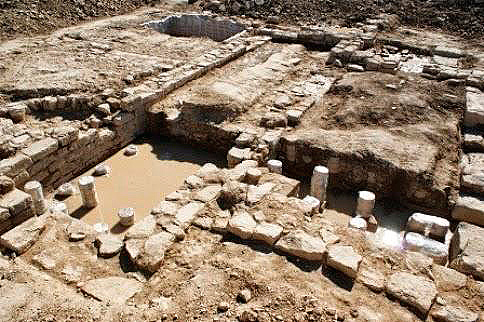
Thermal baths of the Roman villa of San Julián de Beire.
Los Bañales de Uncastillo. As an archaeological site, Los Bañales hides the remains of a Roman city whose name cannot yet be certified with certainty. For many years, the only thing that has been studied in detail about this city was its hydraulic system, with monumental baths - built at the end of the 1st century AD - and an aqueduct that transported water to the city from a possible nearby reservoir. It was precisely the baths that must have given its name to the site and to the ancient dedication of Nuestra Señora de Los Bañales, whose Shrine of Our Lady of Fair Love presides over the archaeological site area .
In recent years, since 2008, thanks to the efforts of the Uncastillo Foundation and the General Administration de Patrimonio del Gobierno de Aragón, the research site has been taken up again and areas of the city's urban planning have been uncovered, including the water supply system, with a dam, an aqueduct, various canals and thermal baths.
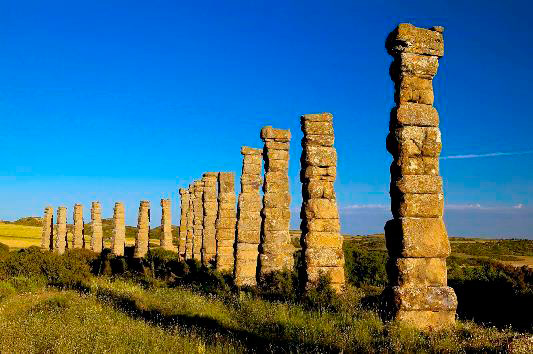
Aqueduct of the Roman city of Los Bañales de Uncastillo.
